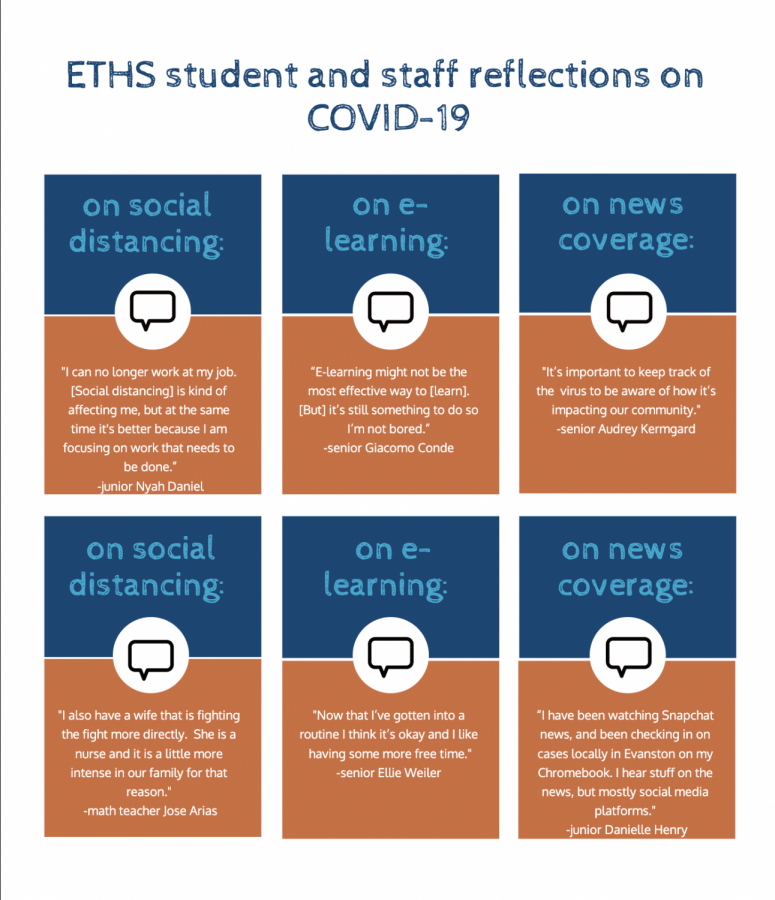Students adjust to social isolation, e-learning
April 3, 2020
Contributor: Tamara Guy
Reactions to social distancing
In the wake of COVID-19 and ETHS’ recent announcement about extending the district-wide closure to April 30, many ETHS students have turned to members of their communities to understand what is happening. However, the practice of social distancing, or “remaining out of congregate settings, avoiding mass gatherings, and maintaining distance,” according to the Center for Disease Control (CDC), has forced many ETHS students to communicate with their friends and teachers online, despite potential challenges.
“I’ve definitely felt very isolated from other people, especially the first few days. The good part of school is getting to be around your friends, and they cancelled that part, [but] I started actually communicating with people online,” sophomore Helen Davis says.
Despite social distancing being the surest way to limit the spread of this virus, some ETHS students have found it difficult to manage.
“I think a lot of people are struggling with [social distancing]. I know I am. I think everything seems kind of far away and weird,” sophomore Parker Rosenthal says.
In response to natural feelings of sadness or loneliness that may come with social distancing, many organizations, media outlets and scientists have published articles acknowledging the challenges of the time and tips to cope. Similarly, some ETHS students have found ways to cope and take care of themselves during this time.
“Social distancing has affected me by just knowing my worth when it comes to mental health,” junior Danielle Henry says. “[But] just knowing, and taking the time to understand how important it is for me to take care of my mental health [helps], especially making sure to check in with myself when being social, but not being physically social.”
Reactions to e-learning
Beyond just social distancing, e-learning is also impacting students and the way students learn. Also, many students have been impacted by ETHS’s announcement earlier this week about extending the school closure to April 30.
“I think it makes sense with what’s happening since going to school would probably cause harm. I think e-learning is a good way to make up for that,” junior Alex Johnson says.
Throughout the extended school closure, teachers have still been trying to support their students from afar.
“From the conversations that I’ve had with many teachers, a lot of them are trying to figure out how to support students, not just academically, but socially and emotionally as well,” Teachers’ Council president and science teacher GionMatthias Schelbert says.
Last year, ETHS had its first e-learning day, which was designed to ensure that students wouldn’t have to make up the required number of instructional days at the end of the year. These protocols were adopted by the Illinois State Board of Education (ISBE) in public act 101-0012, allowing all schools throughout Illinois to take advantage of e-learning. Despite e-learning days not being new to the ETHS community, having such a long period of remote learning has not been done before.
However, Governor J.B. Pritzker’s recent implementation of Act of God days caused some confusion for students about grades and accountability for assignments.
“It has been confusing because some haven’t posted assignments and some teachers have been posting a lot with no due dates. Some teachers claimed during the Act of God Days they weren’t grading so I didn’t understand the point,” junior Nyah Daniel says.
According to the Illinois State Board of Education (ISBE), March 17-30 were deemed Act of God days, or days in which, “E-learning during the mandated closure will not count as an Instructional Day on the school calendar.” However, ISBE did recommend that schools continue to provide learning opportunities for students throughout the Act of God days, which was seen in the assignments that teachers pushed out during that time.
In practice, e-learning assignments can often be difficult for teachers to facilitate due to their own circumstances at home during the statewide “stay-at-home” order.
“I am blessed to have two wonderful girls (one and three years old). The hardest part about [e-learning] is that my girls do not know the difference between me being at home during the weekend to me being at home while working,” math teacher Jose Arias says. “I also have a wife that is fighting the fight more directly. She is a nurse and it is a little more intense in our family for that reason.”
Some students feel it has been difficult to have less contact with teachers and challenging to complete the remote assignments. Students like Henry attribute the stress of e-learning process to “the amount of work given but also because I don’t have a teacher teaching me which becomes confusing.”
In attempts to make E-learning an equitable experience for all, ETHS has also worked to ensure that all students have internet access at home by providing portable WiFi hotspots. For students who don’t have access to an internet capable device, they can fill out an excused absence form on school days, according to the ETHS website.
“E-learning might not be the most effective way to [learn], it’s still something to do so I’m not bored,” senior Giacomo Conde says.
News about the novel coronavirus
In addition to the potential challenges that come with social distancing and e-learning, some students feel that much of the available information from news outlets conflicts, resulting in a situation that is harder to navigate.
“At a certain point, I just started not listening to the news anymore because it’s just constantly arguing about the coronavirus,” Rosenthal says.
As coronavirus dominates the news cycle day after day, students find their information about the pandemic from various sources: The New York Times, CNN, their parents and even social media.
“[I get news from] the emails from the schools, sometimes I watch the news, but mainly my mom tells me or Snapchat news,” Daniel says.
However, some students are concerned about those who only get their news about coronavirus through social media because of how easy it is to spread misinformation through those apps.
“I think we need to be careful of what we read on social media. It’s really easy to spread rumors about what the virus is impacting,” senior Audrey Kermgard explains.
For example, the theory that the Chinese government created the coronavirus as a bioweapon was originally published on Reddit and quickly gained traction as fact on many social media sites. This theory was disputed by many researchers, as no evidence exists to support it.
Misinformation about the coronavirus can also have deadly consequences. On March 21, President Trump tweeted that two drugs, hydroxychloroquine and azithromycin, “have a real chance to be one of the biggest game changers in the history of medicine.” However, these drugs are not FDA approved to treat coronavirus, according to Axios.
Four days after Trump posted that tweet, a man in Arizona died from taking a non-pharmaceutical version of chloroquine found in additives used to clean aquariums, according to CNN. His wife, who also took chloroquine and is in critical condition, told NBC news that she first heard of taking chloroquine as a possible treatment for coronavirus from President Trump in a televised briefing.
“However, I think a lot of ETHS students are smart about getting their information from reliable sources,” Kermgard adds.
Some teachers also post resources on their Google Classrooms to update students on the coronavirus and ensure they’re receiving accurate information, according to some students interviewed by The Evanstonian.












